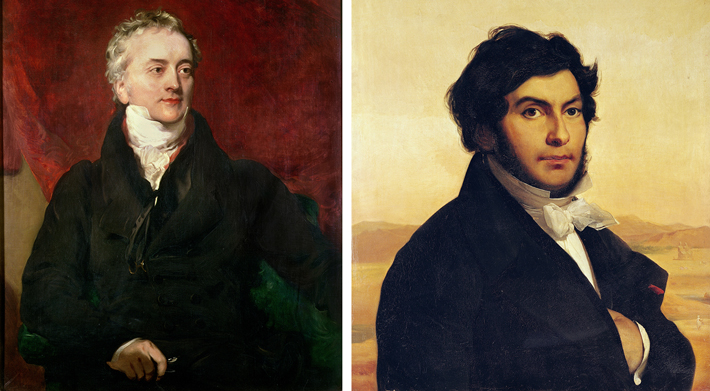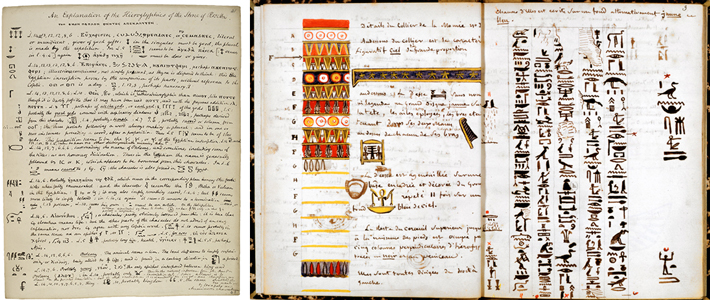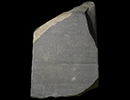The Race to Crack the Code
November/December 2017
 Almost immediately after it was discovered in 1799, the Rosetta Stone was recognized as the potential key to decoding hieroglyphics and the long-lost language of the ancient Egyptians. The inscription, the Third Memphis Decree, was written three times on the stone in three different scripts: hieroglyphics (the sacred script of the temples), Egyptian Demotic (the script of everyday native Egyptian use), and Ancient Greek (the language of the ruling Ptolemaic Dynasty). Although scholars were still unable to read the first two, Ancient Greek was well known, and the Greek text on the stone provided a starting place from which to finally decipher the other two. For hundreds of years European scholars had attempted in vain to translate Egyptian hieroglyphics. When news of the Rosetta Stone’s discovery reached Europe, the race was on.
Almost immediately after it was discovered in 1799, the Rosetta Stone was recognized as the potential key to decoding hieroglyphics and the long-lost language of the ancient Egyptians. The inscription, the Third Memphis Decree, was written three times on the stone in three different scripts: hieroglyphics (the sacred script of the temples), Egyptian Demotic (the script of everyday native Egyptian use), and Ancient Greek (the language of the ruling Ptolemaic Dynasty). Although scholars were still unable to read the first two, Ancient Greek was well known, and the Greek text on the stone provided a starting place from which to finally decipher the other two. For hundreds of years European scholars had attempted in vain to translate Egyptian hieroglyphics. When news of the Rosetta Stone’s discovery reached Europe, the race was on.
Although several renowned intellectuals tackled the inscription, the competition to decipher Egyptian hieroglyphics essentially became a contest between two men, Thomas Young and Jean-François Champollion. Young was an English physician, polymath, and one of the brightest minds of his generation. Champollion, a Frenchman, was a prodigious linguist. One of the difficulties facing both men was determining whether Egyptian hieroglyphics even constituted a spoken language. Did the written characters and pictures denote letters, syllables, or words, or were they solely ideographic symbols representing an idea or action like today’s “no smoking” icons or emojis. These convey concepts, but do not represent speech.

Fueled by their rivalry, both men made progress, especially in determining that when certain hieroglyphic symbols were grouped together within an oval enclosure, or cartouche, they represented the personal name or title of a ruler. Because the Rosetta Stone inscription records the name “Ptolemaios” so frequently, it was possible to identify the cartouche and hieroglyphic characters that spelled out the Greek pharaoh’s name in the Egyptian text on the stone. It was a stunning breakthrough: Individual hieroglyphic symbols could represent letters or sounds. But while letters could be recognized, neither man knew anything about the language itself. Champollion then began to follow a different path. He looked to Egyptian Coptic, the little-known surviving liturgical language of Egyptian Christians, as he believed it might have been related to ancient Egyptian. He was right. In 1822, Champollion finally solved the riddle—he was able to read hieroglyphics. Purportedly, he rushed into his brother’s office exclaiming, “I’ve got it!” before collapsing on the floor. Champollion had discovered that while hieroglyphs were sometimes ideograms, representing an object directly—the character of a lion can actually mean “lion”—they had phonetic value as well. For example, in hieroglyphics, the lion symbol also represents the letter L, the snake the letter J, the open hand the letter D. A somewhat poignant footnote to Champollion’s work is that he never actually saw the Rosetta Stone.
|
Feature:
|

In the Time of the Rosetta Stone
|
Advertisement
IN THIS ISSUE
From the Trenches
The Hidden Stories of the York Gospel
Off the Grid
Iconic Discovery
Arctic Ice Maiden
Desert Life
Living Evidence
Putting on a New Face
Fit for a Saint
The Glass Economy
Henry VIII’s Favorite Palace
Itinerant Etruscan Beekeepers
Spain’s Silver Boom
Conspicuous Consumption
Tablet Time
By the Light of the Moon
World Roundup
Viking cod exports, Bronze Age cereal box, Commodore Perry’s Revenge, Easter Island ecology, and Zanzibar’s colonial past
Artifact
A face from the past
Advertisement

Recent Issues
-
 May/June 2024
May/June 2024
-
 March/April 2024
March/April 2024
-
 January/February 2024
January/February 2024
-
 November/December 2023
November/December 2023
-
 September/October 2023
September/October 2023
-
 July/August 2023
July/August 2023
-
 May/June 2023
May/June 2023
-
 March/April 2023
March/April 2023
-
 January/February 2023
January/February 2023
-
 November/December 2022
November/December 2022
-
 September/October 2022
September/October 2022
-
 July/August 2022
July/August 2022
-
 May/June 2022
May/June 2022
-
 March/April 2022
March/April 2022
-
 January/February 2022
January/February 2022
-
 November/December 2021
November/December 2021
-
 September/October 2021
September/October 2021
-
 July/August 2021
July/August 2021
-
 May/June 2021
May/June 2021
-
 March/April 2021
March/April 2021
-
 January/February 2021
January/February 2021
-
 November/December 2020
November/December 2020
-
 September/October 2020
September/October 2020
-
 July/August 2020
July/August 2020
-
 May/June 2020
May/June 2020
-
 March/April 2020
March/April 2020
-
 January/February 2020
January/February 2020
-
 November/December 2019
November/December 2019
-
 September/October 2019
September/October 2019
-
 July/August 2019
July/August 2019
-
 May/June 2019
May/June 2019
-
 March/April 2019
March/April 2019
-
 January/February 2019
January/February 2019
-
 November/December 2018
November/December 2018
-
 September/October 2018
September/October 2018
-
 July/August 2018
July/August 2018
-
 May/June 2018
May/June 2018
-
 March/April 2018
March/April 2018
-
 January/February 2018
January/February 2018
-
 November/December 2017
November/December 2017
-
 September/October 2017
September/October 2017
-
 July/August 2017
July/August 2017
-
 May/June 2017
May/June 2017
-
 March/April 2017
March/April 2017
-
 January/February 2017
January/February 2017
-
 November/December 2016
November/December 2016
-
 September/October 2016
September/October 2016
-
 July/August 2016
July/August 2016
-
 May/June 2016
May/June 2016
-
 March/April 2016
March/April 2016
-
 January/February 2016
January/February 2016
-
 November/December 2015
November/December 2015
-
 September/October 2015
September/October 2015
-
 July/August 2015
July/August 2015
-
 May/June 2015
May/June 2015
-
 March/April 2015
March/April 2015
-
 January/February 2015
January/February 2015
-
 November/December 2014
November/December 2014
-
 September/October 2014
September/October 2014
-
 July/August 2014
July/August 2014
-
 May/June 2014
May/June 2014
-
 March/April 2014
March/April 2014
-
 January/February 2014
January/February 2014
-
 November/December 2013
November/December 2013
-
 September/October 2013
September/October 2013
-
 July/August 2013
July/August 2013
-
 May/June 2013
May/June 2013
-
 March/April 2013
March/April 2013
-
 January/February 2013
January/February 2013
-
 November/December 2012
November/December 2012
-
 September/October 2012
September/October 2012
-
 July/August 2012
July/August 2012
-
 May/June 2012
May/June 2012
-
 March/April 2012
March/April 2012
-
 January/February 2012
January/February 2012
-
 November/December 2011
November/December 2011
-
 September/October 2011
September/October 2011
-
 July/August 2011
July/August 2011
-
 May/June 2011
May/June 2011
-
 March/April 2011
March/April 2011
-
 January/February 2011
January/February 2011
Advertisement





